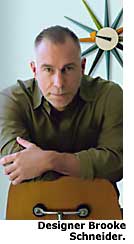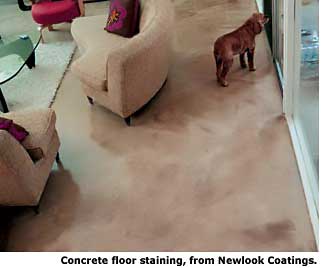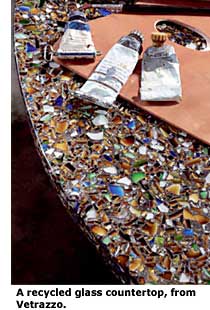Hues That Say You - Page 3

A favorite in Eichler homes with radiant-heated floors, concrete floor staining and topcoats have become more popular as homeowners look to transform plain or damaged concrete floors into unique and colorful works of art.
According to Brian Vicari, who produces cutting-edge concrete designs as the Concrete Colorist, these treated flooring applications can blend seamlessly from indoors to out and actually "take on just about any color, pattern, or texture." Some homeowners look to their floors as a starting place for laying down thematic interior color, points out Jay Anderson, president of Newlook Coatings and Stains in San Jose, "asking us to do variations on color, or multiple colors, on the same job."
Some of today's chicest and most colorful surface options are often the most earth friendly. In 2002, EnviroGlas, of Plano, Texas, started fabricating flooring and countertops made of old glass bottles, mirrors, and windows. With a wide variety of glass and porcelain options and a fully customizable binder (bonding together the pieces of glass or porcelain to form a slab), the color possibilities are endless.
Vetrazzo, located in Berkeley, also offers recycled glass countertops made of 85 percent recycled glass. Colors range from crisp white and arctic blue to amber or firehouse red. Specializing in custom kitchen countertops of the concrete variety, It's Concrete!, based in the East Bay, produces a wide array of color options and inlays that can also provide a burst of color accent.
For those who want to introduce a bold-colored fixture in a room, consider neutrals for the other elements of the space. Using the same stained-wood species in cabinetry installed throughout a home can help unify spaces. Instead of choosing a stainless steel refrigerator, which can bring with it a cool look, Klopf recommends covering large appliances with wood cabinetry that show off the natural grain.

While floors and countertops may be costly to change out, accents such as backsplashes and wall colors are less of an investment.
"People are afraid of color, but if you can talk them through using colors in a limited way, they can have fun and not be scared," Schneider says. "I always recommend that people go neutral with things like flooring and countertops."
The right color palette can help make an inviting impression on a home's exterior, too. Eichler Homes used stains by Cabot Stains, not paint, on their original homes, inside and out. Stain helped to keep the grooves of exterior siding crisp and the silhouette sleek. Over the years, most homeowners covered faded stain with paint.
"Although we're mostly doing coatings with paint nowadays, I encourage Eichler owners to stick with the traditional style of the colors -- deeper earth tones for the body and trim, medium tones for the eaves, and whites or off-whites for the beams and fascia," recommends Lou Palladino, owner of Palladino Painting, based on the San Francisco peninsula.

The Lucas Valley Homeowners Association, made up of nearly 550 Eichler homes in San Rafael, takes great strides to maintain the original personalities of their mid-century homes and the mood of the neighborhood. Strict architectural guidelines, which include paint specifications, help to preserve the community's character. In fact, just about anything that can be viewed from the street must first be approved by the association's Architectural Review Committee.
In Lucas Valley, almost every house is viewed against a backdrop of classic Marin County rolling hills. A house that is too light or too bright will "stand out obtrusively and clash with this otherwise tranquil scene," says Janice Cunningham, the LVHA's business manager. "Most homeowners are understanding of the need to have these guidelines and are happy to follow them."
The association's guidelines are consistent with the design principles followed by Eichler's architects. The LVHA's exterior paint color palette for Eichlers, which is represented by more than 60 colors, is specified as muted earth tones, such as variations of brown, tan, rust, green, and gray. Bright colors are used sparingly, as accents on doors or other key building features. Siding, garage doors, posts, window frames, and doorframes are the same color as the body color. Beams are white, deep brown, or natural wood. Horizontal fascia boards are lighter or darker to complement the body color.
Lou Palladino notes that the narrow foundation at the base of Eichler homes, which is usually painted the same color as a home's siding, can look sharp when painted a dark charcoal gray or black. "If that lower edge is visible, this technique can give the house definition," he says.




